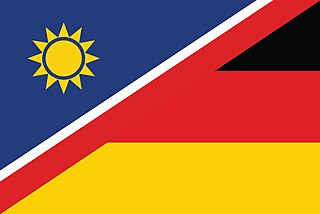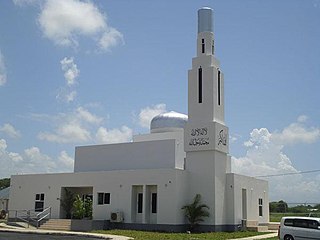
The Herero Wars were a series of colonial wars between the German Empire and the Herero people of German South West Africa. They took place between 1904 and 1908.

Islam is a minority faith in Thailand, with statistics suggesting 4.9% of the population are Muslim. Figures as high as 5% of Thailand's population have also been mentioned. A 2023 Pew Research Center survey gave 7%. Thai Muslims are the largest religious minority in the country.

Islam is one of the largest religions in Nigeria and the country has the largest Muslim population in Africa. In 2018, the CIA World Factbook estimated that 53.5% of Nigeria's population is Muslim. Islam is predominantly concentrated in the northern half of the country, with a significant Muslim minority existing in the southern region. Most of Northern Nigeria is governed under Sharia law, while the rest of the country is governed under secular law.

Islam in Mauritius is the nation's third largest religion behind Hinduism and Christianity. Muslims constitute over 17.3 per cent of Mauritius population. Muslims of Mauritius are mostly of Indian descent. Large numbers of Muslims arrived in Mauritius during the British regime, starting in 1834 as part of the large-scale indentured labor force from India.

South Africa is a Christian majority nation with Islam being a minority religion, practised by roughly 1.6% of the total population. Islam in South Africa has grown in three different phases. The first phase brought the earliest Muslims as part of the involuntary migration of slaves, artisans, political prisoners, and political exiles from the Dutch East Indies to the Cape Colony from 1652 to 1800. The second phase was the arrival of indentured labourers from British India to work in the sugar-cane fields in Natal from 1860 to 1911. Of the approximately 176,000 Indians of all faiths who were transported to the Natal province, almost 7–10% of the first shipment were Muslims.

Islam in Guyana is the third largest religion in the country after Christianity and Hinduism, respectively. According to the 2012 census, 7% of the country’s population is Muslim. However, a Pew Research survey from 2010 estimates that 6.4% of the country is Muslim. Islam was first introduced to Guyana via slaves from West Africa, but was suppressed on plantations until Muslims from British India were brought to the country as indentured labour. The current President of Guyana, Mohamed Irfaan Ali is the first Muslim president.

Islam constitutes the third largest religion in Singapore, with Muslims accounting for approximately 15.6% of the population, as indicated by the 2020 census. Predominantly, Singaporean Muslims are Sunni Muslims adhering to either the Shafi‘i or Hanafi schools of thought. The majority of the Muslim population, about 80%, are ethnic Malays, while 13% are of Indian descent. The remaining fraction comprises local Chinese, Eurasian, and Arab communities, in addition to foreign migrants. Buddhism and Christianity are the two larger religious affiliations in the country.

Islam is the third largest religion in Sri Lanka, with about 9.7 percent of the total population following the religion. About 1.9 million Sri Lankans adhere to Islam as per the Sri Lanka census of 2012. The majority of Muslims in Sri Lanka are concentrated in the Eastern Province of the island. Other areas containing significant Muslim minorities include the Western, Northwestern, North Central, Central and Sabaragamuwa provinces. Muslims form a large segment of the urban population of Sri Lanka and are mostly concentrated in major cities and large towns in Sri Lanka, like Colombo. Most Sri Lankan Muslims primarily speak Tamil, though it is not uncommon for Sri Lankan Muslims to be fluent in Sinhalese. The Sri Lankan Malays speak the Sri Lankan Malay creole language in addition to Sinhalese and Tamil.

German Namibians are a community of people descended from ethnic German colonists who settled in present-day Namibia. In 1883, the German trader Adolf Lüderitz bought what would become the southern coast of Namibia from Josef Frederiks II, a chief of the local Oorlam people, and founded the city of Lüderitz. The German government, eager to gain overseas possessions, annexed the territory soon after, proclaiming it German South West Africa. Small numbers of Germans subsequently immigrated there, many coming as soldiers, traders, diamond miners, or colonial officials. In 1915, during the course of World War I, Germany lost its colonial possessions, including South West Africa ; after the war, the former German colony was administered as a South African mandate. The German settlers were allowed to remain and, until independence in 1990, German remained an official language of the territory alongside Afrikaans and English.

Kenya has a Christian majority, with Islam being the second largest faith representing 11% of the Kenyan population, or approximately 5.2 million people as of 2019 census. The Kenyan coast is mostly populated by Muslims. Nairobi has several mosques and a notable Muslim population. The faith was introduced by merchants visiting the Swahili coast, which led to local conversions and foreign Muslims becoming assimilated. This would later result in the emergence of several officially Muslim political entities in the region.

Panama is a predominantly Christian country, with Islam being a minority religion. Due to the secular nature of Panama's constitution, Muslims are free to proselytize and build places of worship in the country.

Jamaica is a predominantly Christian country, with Islam being a minority religion. Due to the secular nature of Jamaica's constitution, Muslims are free to proselytize and build places of worship in the country.

Zambia is officially a Christian country, with adherents of Islam being at 2.7% minority in the country. However, Zambia's constitution guarantees the freedom of religion and conscience, and Muslims are free to proselytize and build places of worship in the country.

Islam is the largest minority religion in Rwanda, practiced by 2% of the total population according to the 2012 census. Virtually all Muslims in Rwanda are Sunni Muslim. Islam was first introduced into Rwanda by Muslim traders from the East Coast of Africa in the 20th century. Since its introduction, Muslims have been a minority in the territory, while Christianity, was introduced to Rwandans during the colonial period in the beginning of the 20th century, and is now the largest religion in the country.

Tanzania is a Christian majority nation, with Islam being the largest minority faith in the country. According to a 2020 estimate by Pew research center, Muslims represent 34.1% of the total population. The faith was introduced by merchants visiting the Swahili coast, as it became connected to a larger maritime trade network dominated by Muslims. This would lead to local conversions and assimilations of foreign Muslims, ultimately causing the eventual formation of several officially Muslim political entities in the region. However, according to the Association of Religion Data Archives (ARDA), 55.3% of the population is Christian, 31.5% is Muslim, 11.3% practices traditional faiths, while 1.9% of the population is non-religious or adheres to other faiths as of 2020. The ARDA estimates that most Tanzanian Muslims are Sunni, with a small Shia minority, as of 2020.

Islam in Papua New Guinea is a minority religion in the predominantly Christian country, with around 10,000 followers as of 2021. Papuan Muslims are largely concentrated Port Moresby and villages situated in the Highlands. Due to secular nature of the country's constitution, Muslims are free to proselytize and build places of worship in the country.

The earliest evidence of Hinduism in Tanzania is from the 1st millennium AD when there was trade between East Africa and Indian subcontinent. Most of these traders came from Gujarat, Deccan and the Chola empire. Archaeological evidence of small Hindu settlements have been found in Zanzibar and parts of Swahili coast, Zimbabwe and Madagascar.
The term Gujarati Muslim is usually used to signify an Indian Muslim from the state of Gujarat in western coast of India. Most Gujarati Muslims have the Gujarati language as their mother tongue, but some communities have Urdu as their mother tongue. The majority of Gujarati Muslims are Sunni, with a minority of Shi'ite groups.

German South West Africa was a colony of the German Empire from 1884 until 1915, though Germany did not officially recognise its loss of this territory until the 1919 Treaty of Versailles.
Nepalese Muslims are Nepalis who follow Islam. Their ancestors arrived in Nepal from different parts of South Asia, Central Asia and Tibet during different epochs, and have since lived amidst the numerically dominant Hindus and Buddhists. About 80% of the Muslim community live in the Terai region, while the other 20% are found mainly in the city of Kathmandu and Gorkha and the western hills. The community numbers 971,056, about 3.8% of the total population of Nepal. Districts with large Muslim population include Sarlahi (9.9%), Rautahat (17.2%), Bara (11.9%), and Parsa (17.3%) and Banke (16%) in the western Terai and Siraha (7%) and Sunsari (10%) and Saptari (10%) Gorkha (13%) hill.










